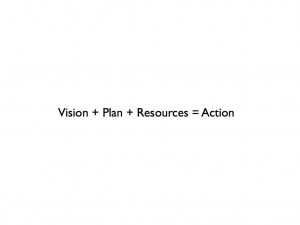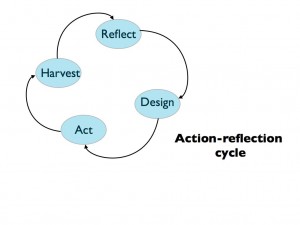Visioning as the estuary of action
BC, Design, Emergence, Flow, Improv, Leadership, Learning, Open Space, World Cafe

This is an estuary. It is the place where a river goes to die. Everything the river has ever been and everything it has carried within it, is deposited at it’s mouth where the flow slows down and the water merges with the ocean. These are places of incredible calm and richness, but they lack the exciting flow of the torrents and waterfalls and cascades of the upper river system.
Yesterday I was speaking with a client who worried that an initiative we had begun together was heading towards the estuary of action – a long term visioning processes where lots of things are said and very little is done. “We’ve done that before,” she said. Nobody likes that. I wracked my brain to see where it was that I had led this group to believe that this is what we were doing. We had done a World Cafe to check into some possibilities for the organization and we had done a short Open Space to initiatie some experimental actions. We had learned a little about the organization from these two gatherings, and we were, at least in my mind, fully entered into a participatory action learning cycle, working with emergent ideas, within several well established constraints. I was surprised to hear the fear spoken that what we were doing was “visioning.”
Then I realized that what we were dealing with was an entrained pattern. People within this organization associated dialogue with visioning, and the results of dialogue with a mass of post-it notes and flip charts that never get typed up, and action that never comes of it. Likewise, it turns out that the associated planning with a process that begins with a vision, and then costs out a plan and takes that plan to a decision making body which then rules on whether the project can proceed, by allocating resources. Both of these views are old thinking, rigid patterns that lock participants in a linear view of action that looks like this:
The truth is that I had been viewing the process as an action learning cycle:


So now that we are a little clearer on this, there was a distinct relaxation among the group. We are heading into some uncharted territory and it is too early to nail down concrete plans about what to do and likewise simply visioning doesn’t take us anywhere either. Instead, we are harvesting some of the rich sense of community that exists, opening some space for a little leadership, inviting passion and responsibility and making small starts, The small starts are confirming some of what we suspected about how the organization works, which is good news, because we are developing a pattern of action together that will help us all as we move forward to do bigger things with more extensive resource implications. This is the proper role of vision and planning in emergent and participatory processes – gentle, developmental, reflective and active.




Beautifully articulated–thanks, Chris.